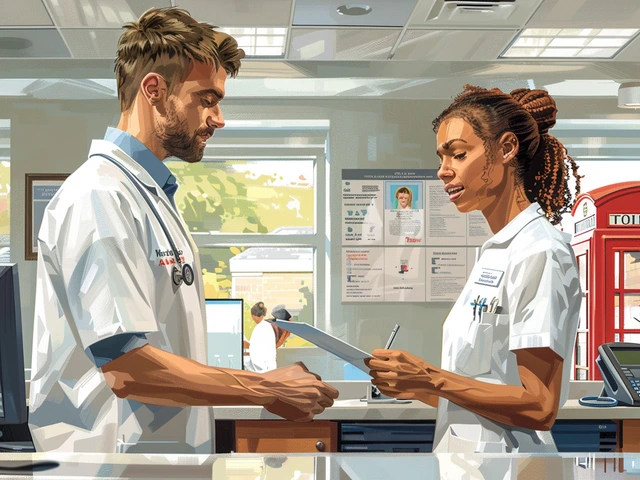
Understanding Chronic Lymphocytic Leukemia
As a blogger, my job is to provide you with accurate and easy-to-understand information. Chronic Lymphocytic Leukemia (CLL) is a type of cancer that starts in the bone marrow and then invades the blood. Unlike other types of leukemia, CLL often progresses slowly, so it's also known as a slow-growing leukemia. It primarily affects older adults and accounts for about one-third of all leukemia cases. The disease rarely affects children.
Common Symptoms of Chronic Lymphocytic Leukemia
The symptoms of CLL can be quite varied, from mild to severe. Some people may not show any symptoms at all, while others may experience swollen lymph nodes, fatigue, weight loss, frequent infections, and a sense of fullness in the stomach. It's important to remember that these symptoms can also be caused by other, less serious conditions. Therefore, if you have any of these symptoms, it's essential to see a doctor for a proper diagnosis.
Chronic Lymphocytic Leukemia and Increased Risk of Other Cancers
Studies have shown that people with CLL have an increased risk of developing other types of cancer. This can include skin cancer, lung cancer, and other types of leukemia. The reasons for this increased risk are not fully understood, but it's thought that the damage to the immune system caused by CLL may play a role.
Common Secondary Cancers After Chronic Lymphocytic Leukemia
After a CLL diagnosis, some patients may develop what's known as secondary cancers. These can include non-melanoma skin cancers, lung cancer, and other types of leukemia. The risk of developing these secondary cancers is higher in the first year after diagnosis, but the risk remains elevated for several years.
The Role of the Immune System
Our immune system is designed to protect us from diseases, including cancer. However, CLL can weaken our immune system, making it easier for other cancers to develop. This is why it's so important for people with CLL to have regular check-ups and screenings for other types of cancer.
Genetic Factors in Chronic Lymphocytic Leukemia
Genetics can also play a role in the development of CLL and other cancers. Certain gene mutations have been linked to an increased risk of developing CLL. It's important to note that not everyone with these gene mutations will develop CLL or other cancers, but they are at a higher risk.
The Role of Lifestyle and Environment
Lifestyle and environmental factors can also contribute to the risk of developing CLL and other cancers. For instance, exposure to certain chemicals or radiation can increase the risk. Smoking is a well-known risk factor for many types of cancer, including CLL. Therefore, maintaining a healthy lifestyle can help reduce the risk.
Preventing Secondary Cancers
While it's not possible to completely prevent the development of secondary cancers, there are steps you can take to reduce your risk. This includes regular screenings for other types of cancer, maintaining a healthy lifestyle, and staying up-to-date with immunizations. If you have CLL, speak with your doctor about what steps you can take to reduce your risk.
Conclusion: Living with Chronic Lymphocytic Leukemia
Living with CLL can be challenging, but with the right care and support, it's possible to lead a full and meaningful life. Regular check-ups and screenings are essential for early detection and treatment of secondary cancers. Remember, you are not alone. Reach out to supportive communities and organizations that can provide assistance and information.





Sam Moss
July 26, 2023 AT 17:28Living with CLL often feels like walking a tightrope-each day brings a new balance of hope and uncertainty. The immune system’s quiet rebellion can let other cancers slip through the cracks, so vigilant screenings become a lifeline. It’s striking how lifestyle tweaks, like quitting smoking, can tip the scales toward better outcomes. Genetics may hand you a heavier deck, but environmental choices can still play a winning hand. Keep leaning on support networks; they’re the bright threads stitching the whole picture together.
Suzy Stewart
August 4, 2023 AT 23:41Exactly! 🎉 Regular check‑ups are the armor we need, and staying optimistic supercharges the body’s own defenses. 💪 Don’t let the word “risk” scare you-use it as a roadmap to proactive care. Keep that smile bright, because a positive mindset actually fuels immunity.
Traven West
August 14, 2023 AT 05:54What a roller‑coaster! Your bloodwork numbers hide stories that most people pretend not to read.
Jonny Arruda
August 23, 2023 AT 12:08Cool facts, and a good reminder to keep up with skin checks-sun damage is sneaky.
Melissa Young
September 1, 2023 AT 18:21Watch out for those chemo side‑effects, folks!
SHASHIKANT YADAV
September 11, 2023 AT 00:34Interesting how immune suppression opens the door for secondary malignancies 😊. Staying active and eating plenty of antioxidant‑rich foods can help tighten that door.
Ryan Pitt
September 20, 2023 AT 06:48Right on, buddy! A quick annual dermatologist visit can catch skin cancer early, and you’ll thank yourself later.
Jami Johnson
September 29, 2023 AT 13:01When you consider the genetic mutations that predispose someone to CLL, you start to see a pattern that’s almost philosophical-our DNA writes a story, but we can edit the chapters with lifestyle and medical vigilance. Keeping a detailed family history on hand empowers doctors to tailor surveillance, which can be a game‑changer for early detection of secondary cancers.
Kasey Krug
October 8, 2023 AT 19:14The data is solid: CLL patients have a statistically higher incidence of non‑melanoma skin cancers. Regular dermatology appointments are non‑negotiable.
jake cole
October 18, 2023 AT 01:28Honestly, most of these “tips” are just common sense wrapped in fancy jargon. If you’re not already on a strict follow‑up schedule, you’re basically begging for trouble.
Natalie Goldswain
October 27, 2023 AT 07:41i think the community could use more info on vitamin d benefits.
khajohnsak Mankit
November 5, 2023 AT 12:54Vitamin D, indeed, acts as a modest immunomodulator; its deficiency may subtly erode the already fragile defenses in CLL patients, thereby nudging the probability of secondary malignancies upward.
Jayant Paliwal
November 14, 2023 AT 19:08The interplay between chronic lymphocytic leukemia and subsequent neoplasms is not merely a statistical footnote, it is a complex tapestry woven from immunologic fatigue, genetic predispositions, and environmental exposures, each thread demanding careful scrutiny, each pattern revealing potential intervention points, and while the literature emphasizes the first year post‑diagnosis as a critical window, longitudinal monitoring remains essential, for the risk does not evaporate with time, and a proactive screening regimen can transform a grim prognosis into manageable vigilance, thereby granting patients a semblance of control over an otherwise relentless disease progression.
Kamal ALGhafri
November 24, 2023 AT 01:21From a moral standpoint, ignoring the elevated risk of secondary cancers in CLL patients borders on negligence; knowledge without action is a hollow virtue.
Gulam Ahmed Khan
December 3, 2023 AT 07:34Let’s turn that moral charge into a practical plan: schedule a low‑dose CT scan for the lungs annually and a full skin exam every six months 😊.
John and Maria Cristina Varano
December 12, 2023 AT 13:48its not that hard 2 keep up with the apps and remeber the dates.
Melissa Trebouhansingh
December 21, 2023 AT 20:01Understanding the nuanced relationship between chronic lymphocytic leukemia and secondary malignancies requires a disciplined academic approach. The epidemiological data reveal a clear elevation in incidence rates for skin, lung, and additional hematologic cancers among CLL cohorts. This observation is not a trivial footnote but a cornerstone for patient management strategies. Immunosenescence inherent to CLL compromises tumor surveillance mechanisms. Consequently, malignant clones that would normally be eliminated may persist and expand. Genetic analyses have identified recurring mutations that predispose to both CLL and other neoplasms. For instance, del(13q) and TP53 alterations appear across multiple cancer types. Environmental factors such as tobacco exposure further amplify these risks. Lifestyle modifications, therefore, are not merely adjunctive but integral to risk mitigation. Regular dermatological examinations can detect non‑melanoma skin cancers at an early, curable stage. Low‑dose computed tomography scans offer a viable method for early lung cancer detection in high‑risk patients. Hematologic monitoring, including peripheral blood flow cytometry, can uncover emerging clonal populations before clinical manifestation. Patient education empowers individuals to adhere to surveillance schedules without undue anxiety. Multidisciplinary care teams facilitate coordinated screening and timely intervention. Ultimately, a proactive, evidence‑based surveillance regimen transforms a statistical inevitability into a manageable clinical reality.
Brian Rice
December 31, 2023 AT 02:14While the preceding exposition is replete with grandiloquent assertions, it fails to address the pragmatic constraints faced by many patients, such as insurance barriers and socioeconomic disparities, thereby rendering the proposed surveillance protocol largely aspirational rather than actionable.